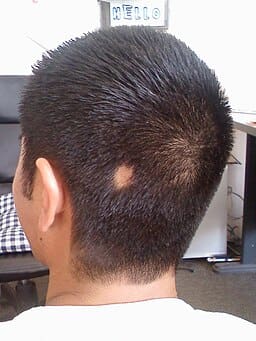Call 973-763-7546 for an Alopecia Areata Consultation
Alopecia areata (AA) is an autoimmune condition in which the immune cells attack hair follicles causing hair loss. Although not a dangerous condition, it can be very distressing. In many cases alopecia areata is self-limiting, and the patches of hair loss resolve spontaneously over several months. However, some cases can be challenging, and relapse is common.

Alopecia areata is often treated with topical corticosteroids, intralesional injection of corticosteroid, topical tacrolimus or pimecrolimus, and phototherapy, including excimer laser. Sometimes systemic therapy with corticosteroids is used, often on an intermittent basis. But long-term systemic corticosteroid use has a multitude of side-effects, so is typically not a treatment that can be maintained long-term.
Methotrexate, an antimetabolite, is used to treat many inflammatory conditions, including psoriasis. There are studies that support its use in the treatment of alopecia areata. A recent systemic review of the treatment of alopecia areata with methotrexate further supports this approach. Overall, a good response was seen in 63% of patients and a complete response in 36% of patients. However, it takes 6-12 months to achieve complete regrowth. It should be noted that methotrexate was most effective as an adjunct to systemic corticosteroids and should be used in combination. Overall, methotrexate can be considered as an adjunct therapy in severe cases of alopecia areata in adults and children.
Methotrexate has many potential adverse effects and should only be prescribed by an experienced physician. Most common side-effects are hematologic and hepatic and regular monitoring is required.
